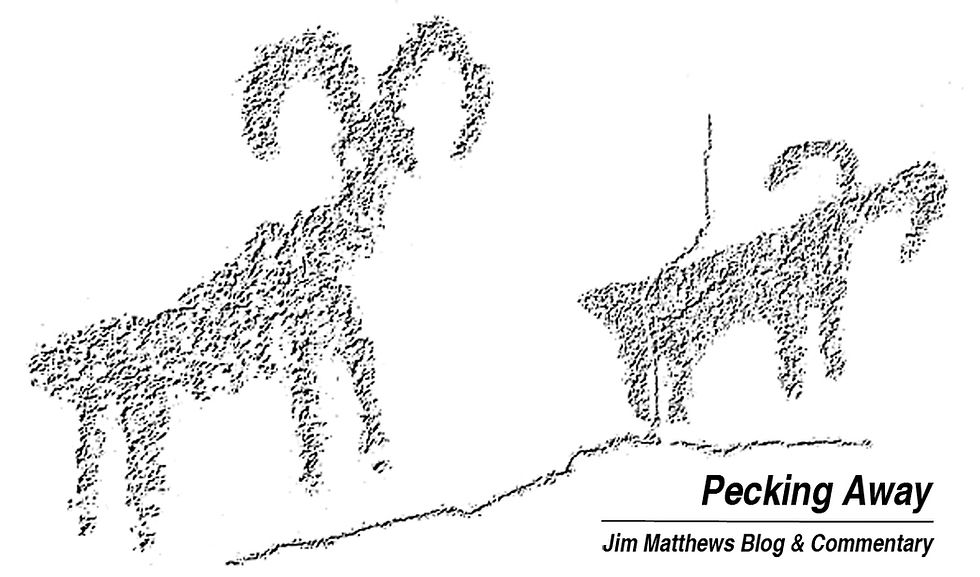Topoc Marsh hog removal proposal is a gross waste of wildlife funding
- Jim Matthews
- Nov 13, 2016
- 4 min read

By JIM MATTHEWS
www.OutdoorNewsService.com
This is why people hate government.
The Lake Havasu National Wildlife Refuge staff has recently released its “feral swine eradication program.” If implemented as written, it is going to cost a boat-load of money that could better be spend on other wildlife and habitat improvement programs.
There is no question wild hogs are hard on landscapes and other wildlife. There is no question that reducing hog numbers on the Topoc Marsh portion of the refuge is a good idea for reptiles, amphibians, and nesting birds. No one is arguing against the need to reduce hog numbers. But….
I read the whole plan and nowhere in the plan does it give essential information:
-- There is no estimate the wild hog population.
-- There is no estimate of the costs involved with the aerial gunning, trapping, and other plans they suggest to remove the hogs.
-- There is no documentation of environmental damage occurring. There is only literature references about what could happen. Nothing about what is happening.
So it is hard to justify the unnamed (but sure to be massive) expenses in the proposal, and it doesn’t explain (at least to any sane person’s satisfaction) why other control methods have been eliminated from consideration.
The one thing that is dismissed out-of-hand is a public hunting program to eliminate or at least reduce hog numbers to low enough levels that damage becomes minimal. Ironically, their own document points out that a permit hunt in 1975 allowed 175 hunters on the area in series of 25-permit hunts and they killed 42 hogs.
The document says administrative costs were high to run the hunt. (Higher than aerial gunning?) No figures were given, but it was too high. No comparison to other methods on a cost-per-dead-hog basis was provided.
This proposal is an exercise is wasting money.
The Cleveland National Forest also went to the expense of writing a hog removal program when pigs started showing up in the forest along the San Diego River. Fortunately, the state Fish and Wildlife told public hunters they could kill pigs on the Cleveland the problem pretty much disappeared. There are still pigs there, but the numbers are small and when a few show up in an area, public hunters move in and kill a few and scatter the rest, reducing the impact on habitat to less than what hikers or mountain bikers cause every weekend. The Cleveland’s plan has never been implemented.
The other factor that the refuge and the Cleveland staff failed to factor in was that eradication is simply impossible in both places. They can only implement their eradication efforts on the federal lands, the adjoining private and Indian reservation lands will continue to have wild hogs that will return to the federal lands. The whole idea of “eradication” is a fool’s errand.
I hate to call out the biologists on this, but for the limited amount of habitat along the Colorado River, I suspect that 42 hogs killed in 1975 was a sizeable chunk of the hog population. The hog population has built back up since then so refuge staff is seeing more and more hogs.
A public hunting program would keep the pig numbers down, probably below the threshold level where they can cause significant damage. If the refuge just declared open season on the pigs, making them a year-around hunted species, hunters would jam the place (initially) and whack a lot of pork for the dinner table. (The fact the federal “removal” program would simply leave the pigs to rot, is annoying to a lot of us, too.)
The refuge document says the staff is concerned about public safety with a public hunting program because habitat is so dense in most areas. This shows a profound ignorance about firearms, and how safely most hunters behave. But if they just wanted to limit the hunt to short-range shotguns firing buckshot or slugs, the hunters would comply and kill a lot of pigs. The reality is that you don’t need to have permit hunts (reducing administrative costs). You could just define open areas, and turn us loose.
The refuge staff owes it to their budget and taxpayers to try the least expensive options first. First you have to define the damage. Second, you have to estimate the number of hogs so you can evaluate future reduction and removal efforts.
Lastly, hunters would pay for the permits to hunt wild hogs if the cost was reasonable. Have a couple of self-service kiosks in the pig areas where hunters can get a permit and drop their $10 permit fee off with a mechanical ranger. It deserves a try.
The refuge proposal is the “go big or go home” option. Even if successful, this is an option destined to fail when the pigs come back (and they will come back).
This is why people hate government.
END
[Jim Matthews is a syndicated Southern California-based outdoor reporter and columnist. He can be reached via e-mail at odwriter@verizon.net or by phone at 909-887-3444.]























Comments